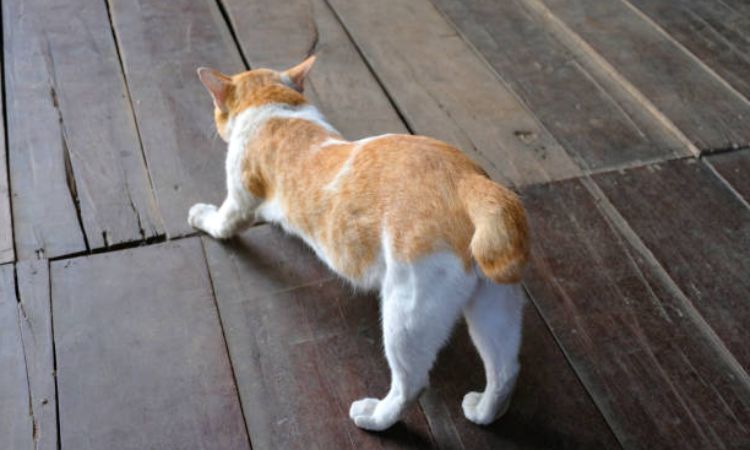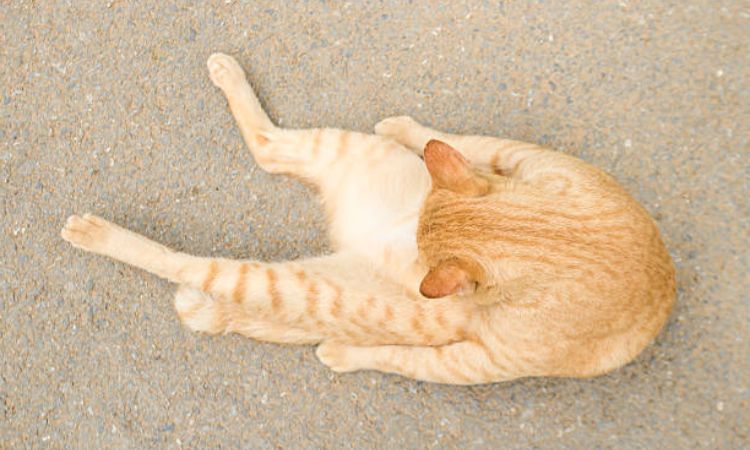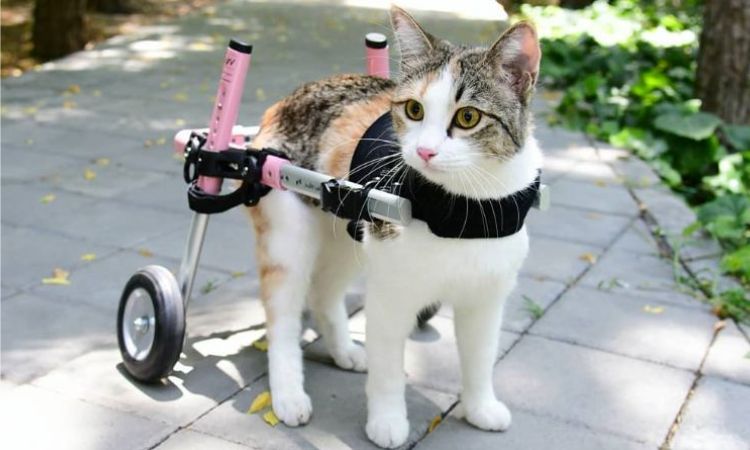Every cat should move with grace, their hind legs propelling them effortlessly across the room, up a tree, or onto a favorite perch. But when those back legs suddenly falter, wobble, or give way entirely, it’s alarming for both pet and owner.
Weakness in the hind limbs can signal anything from a minor strain to a serious medical condition, making timely recognition and action critical. Keep reading to explore the causes, warning signs, and essential steps to help a cat whose back legs have unexpectedly weakened.

What Is Sudden Back Leg Weakness in Cats?
Sudden back leg weakness in cats occurs when a feline’s hind limbs abruptly lose strength, coordination, or stability, making walking, jumping, or even standing difficult. Unlike gradual weakness, which develops slowly over time due to aging, arthritis, or chronic metabolic conditions, sudden weakness appears almost overnight and often signals an urgent underlying medical issue.
It’s important to distinguish between weakness, paralysis, and limping, as each presents differently:
- Weakness refers to a lack of strength in the muscles, causing the cat to struggle to support its weight, wobble, or drag its hind legs.
- Paralysis is a complete loss of voluntary movement in one or both back legs, which may be accompanied by a loss of sensation.
- Limping often indicates pain, injury, or discomfort, but the cat can still move the affected limb to some extent.
Sudden hind leg weakness is particularly concerning because it may reflect a medical emergency. Conditions such as spinal trauma, blood clots (aortic thromboembolism), severe neurological disorders, or acute metabolic issues can cause rapid deterioration. Immediate veterinary attention is crucial, as prompt diagnosis and treatment can prevent permanent damage, relieve pain, and in some cases, save the cat’s life.
Common Causes of Sudden Back Leg Weakness in Cats
Sudden weakness in a cat’s hind legs can be alarming, and understanding the underlying cause is essential for prompt treatment. While some causes are minor, others can be life-threatening, so it’s important to know what to watch for.
1. Blood Clot (Saddle Thrombus / Feline Aortic Thromboembolism)
A saddle thrombus, or feline aortic thromboembolism (FATE), occurs when a blood clot blocks the main artery supplying the hind legs.
- How it affects the legs: The clot drastically reduces or completely cuts off blood flow to the hind limbs, causing sudden paralysis, cold and pale paws, and extreme pain.
- Why it’s life-threatening: This is an emergency. Without immediate veterinary intervention, the lack of blood supply can cause permanent tissue damage, and the clot may indicate underlying heart disease that can be fatal.
2. Trauma or Injury
Physical injuries are a common cause of sudden hind leg weakness.
- Examples: Falls, car accidents, fights, or internal injuries.
- Effects: Fractures, sprains, or soft tissue damage can make it difficult or impossible for a cat to use their back legs.
- Action: Immediate veterinary care is necessary to assess for fractures, internal bleeding, or nerve involvement.
3. Spinal Cord Issues
Problems affecting the spine can interrupt nerve signals to the back legs.
- Common causes: Slipped discs, spinal fractures, tumors, or compression injuries.
- Symptoms: Sudden hind leg weakness, wobbling gait, or complete paralysis in severe cases.
- Note: Spinal injuries are urgent and require prompt veterinary diagnosis to prevent permanent damage.
4. Neurological Disorders
Diseases affecting the nervous system can disrupt the signals controlling limb movement.
- Examples: Nerve damage, seizures, or brain/spinal problems.
- Symptoms: Weakness, lack of coordination, trembling, or sudden inability to move the hind legs.
- Importance: Early detection can help manage the condition and prevent worsening paralysis.
5. Heart Disease
Heart conditions, such as cardiomyopathy, can predispose cats to blood clots that travel to the hind limbs.
- Effect on back legs: Reduced circulation from clots leads to sudden weakness, pain, and immobility.
- Emergency: These cases require immediate veterinary intervention to relieve pain and address the underlying heart condition.
6. Hypoglycemia or Metabolic Disorders
Sudden drops in blood sugar or electrolyte imbalances can affect muscle and nerve function.
- Examples: Diabetic cats with poor glucose control, kidney disease, or thyroid problems.
- Symptoms: Weakness, lethargy, trembling, and difficulty standing or walking.
- Action: These conditions often require urgent medical attention and stabilization.
7. Toxins or Poisoning
Certain toxins can cause sudden hind leg weakness.
- Examples: Ingested chemicals, plants, or medications toxic to cats.
- Symptoms: Weakness, tremors, vomiting, or collapse.
- Urgency: Poisoning is an emergency, and rapid veterinary care can be life-saving.
8. Arthritis Flare-Up (Less Common for Sudden Onset)
While arthritis usually develops gradually, a flare-up can sometimes lead to temporary hind leg weakness.
- Effect: Pain and stiffness may make walking or jumping difficult.
- Note: Sudden paralysis is rare in arthritis; this is usually a slower progression.

Key Symptoms to Watch For
Recognizing the warning signs of hind leg weakness in cats is essential, as some causes can be life-threatening. Here are the key symptoms to monitor:
- Inability or Difficulty to Stand on Hind Legs: Cats may struggle to support their weight, wobble when standing, or be unable to get up from a resting position. This is often an early sign of weakness or paralysis.
- Dragging Back Legs or Sudden Collapse: If a cat’s hind legs suddenly give out, they may drag their legs while moving or collapse entirely. Sudden collapse is especially concerning and may indicate a clot, spinal injury, or severe neurological problem.
- Pain Vocalization, Crying, or Panting: Cats in acute pain may vocalize, cry, or pant. This is commonly seen with blood clots (saddle thrombus), trauma, or severe arthritis flare-ups. Immediate attention is needed if the cat shows signs of severe distress.
- Back Legs Cold to the Touch: Cold, pale, or bluish hind legs are a critical warning sign of restricted blood flow, often caused by a saddle thrombus. This requires emergency veterinary care.
- Loss of Bladder or Bowel Control: Inability to control urination or defecation may accompany paralysis or severe nerve/spinal cord issues. This indicates significant neurological involvement and needs urgent assessment.
- Sudden Lethargy, Weakness, or Heavy Breathing: Cats may appear unusually tired, reluctant to move, or breathe heavily. These signs often accompany systemic issues like heart disease, metabolic disorders, or blood clots.
- One Leg Affected vs Both Legs — What It May Mean
- One hind leg affected: Often due to trauma, localized nerve injury, or muscle damage.
- Both hind legs affected: Could indicate blood clots, spinal cord issues, metabolic disease, or neurological disorders — often more serious.
Any sudden changes in your cat’s ability to use their back legs should be taken seriously. Early recognition of these symptoms and prompt veterinary evaluation can make a significant difference in recovery and prevent permanent damage.
Diagnosis and Treatment by a Veterinarian
When a cat shows sudden weakness or paralysis in the hind legs, prompt veterinary evaluation is essential. A veterinarian will carefully assess the situation to identify the underlying cause and determine the most effective treatment.
1. Physical Examination
The first step is a thorough physical exam. The veterinarian will:
- Check your cat’s reflexes to see how the nervous system responds.
- Assess pulses and paw temperature, which can indicate blood flow issues, such as a clot in the legs.
- Look for signs of pain or discomfort, noting whether your cat vocalizes, flinches, or resists touch.
- Examine for external injuries, swelling, or the presence of ticks, which can contribute to neurological or circulatory problems.
This hands-on evaluation helps the vet determine whether the weakness is due to trauma, nerve damage, blood flow problems, or other conditions.

2. Diagnostic Tests
To pinpoint the exact cause of the hind leg weakness, the veterinarian may recommend a combination of tests:
- Blood work and urinalysis to detect infections, metabolic disorders (like diabetes), or organ dysfunction.
- X-rays to identify fractures, arthritis, or structural abnormalities in the spine or limbs.
- Advanced imaging, such as CT scans or MRI, to evaluate spinal cord injuries, tumors, or nerve damage.
These tests provide a clear picture of the cat’s overall health and help identify serious conditions such as feline aortic thromboembolism (FATE), neurological disorders, or heart disease-related complications.
3. Treatment
Treatment is completely dependent on the underlying diagnosis. Options may include:
- Hospitalization for intensive monitoring, pain management, or supportive care.
- Medications to address pain, inflammation, infection, or circulatory problems.
- Physical therapy and rehabilitation to help restore strength, mobility, and coordination in affected limbs.
- Surgery in severe cases, such as spinal injuries, fractures, or to remove obstructions like blood clots.
A veterinarian will develop a tailored treatment plan based on the cat’s condition, ensuring both immediate relief and long-term support. Early intervention is critical to improving outcomes, preventing complications, and giving your cat the best chance for recovery.
Your role as a pet owner is to be an advocate for your cat’s health. When faced with a sudden and alarming symptom like hind leg weakness, the most crucial step is to seek immediate veterinary care. Don’t delay—your quick response can make a significant difference in your cat’s outcome and overall well-being.






